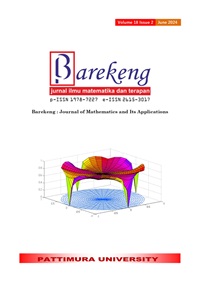CRAMER’S RULE IN MIN-PLUS ALGEBRA
Abstract
Cramer’s rule is one of a method for solving a system of linear equations in conventional algebra. The system of linear equation can be solved using Cramer’s rule if . Max-plus algebra is a set where is a set of real numbers, equipped with biner operations and where and . Min-plus Algebra is a set where is a set of real numbers, equipped with biner operations and where and . In max-plus algebra has been formulated Cramer’s rule to solve a system of linear equations. Because max-plus algebra is isomorphic to min-plus algebra, Cramer’s rule can be formulated into min-plus algebra. The purpose of this research is to determine the sufficient conditions for a system of linear equations can be solved using Cramer’s rule. The method used in this research is a literature study that reviews previous research related to min-plus algebra, max-plus algebra, and Cramer’s rule in max-plus algebra. By using the appropriate analogy in max-plus algebra, we can determine the sufficient conditions so that a system of linear equations in min-plus algebra can be solved using Cramer’s rule. Based on the research, the sufficient conditions for a system of linear equations can be solved using Cramer’s rule are for and with the Cramer’s rule is . For an invertible matrix A, Cramer’s rule can be written as .
Downloads
References
H. Anton and A. Kaul, Elementary Linear Algebra, 12th ed. Hoboken: John Wiley and Sons, Inc, 2019.
D. C. Lay, S. R. Lay, and J. J. McDonald, Linear Algebra and its Applications, 5th ed. New York: Pearson Education, Inc, 2016.
W. A. Nowak, “The Tropical Eigenvalue-Vector Problem from Algebraic, Graphical, and Computational Perspectives Recommended Citation,” Thesis, University of Bates Collages, Lewiston, 2014.
A. A. Aminu, S. E. Olowo, I. M. Sulaiman, N. A. Bakar, and M. Mamat, “On Application of Max-Plus Algebra to Synchronized Discrete Event System,” Mathematics and Statistics, vol. 9, no. 2, 2021.
P. Butkovic and D. Jones, “On special cases of the generalized max-plus eigenproblem,” SIAM Journal on Matrix Analysis and Applications, vol. 37, no. 3, 2016.
T. Žužek, A. Peperko, and J. Kušar, “A Max-Plus Algebra Approach for Generating a Non-Delay Schedule,” Croatian Operational Research Review, vol. 10, no. 1, pp. 35–44, 2019.
Subiono, Aljabar Min-Max Plus dan Terapannya, 3rd ed. Surabaya: Jurusan Matematika ITS, 2015.
K. G. Farlow, “Max-Plus Algebra,” Thesis, Virginia Polytechnic Institute and State University, Virginia, 2009.
G. J. Olsder and C. Roos, “Cramer and Cayley-Hamilton in the Max Algebra,” Linear Algebra and It’s Aplications , vol. 101, pp. 87–108, 1988.
S. Watanabe and Y. Watanabe, “Min-Plus Algebra and Networks (Novel Development of Nonlinear Discrete Integrable Systems),” RIMS Kôkyûroku Bessatsu, vol. 47, pp. 41–54, 2014.
Musthofa, “Sistem Persamaan Linear pada Aljabar Min-Plus,” in Prosiding Seminar Nasional Penelitian, Pendidikan dan Penerapan MIPA, 2011, pp. 275–284.
M. A. Rudito, “Sistem Persamaan Linear Min-Plus dan Penerapannya pada Masalah Lintasan Terpendek,” in Prosiding Seminar Nasional Matematika dan Pendidikan Matematika FMIPA UNY, Yogyakarta, 2013, pp. 29–34.
D. A. Adilla, “Sistem Persamaan Linear dalam Aljabar Min-Plus,” Skripsi, Universitas Sebelas Maret, Surakarta, 2021.
Siswanto, A. Gusmizain, and S. Wibowo, “Determinant of a Matrix Over Min-Plus Algebra,” Journal of Discrete Mathematical Sciences and Cryptography, vol. 24, no. 6, pp. 1829–1835, 2021.
A. Guzmizain, “Invers dan Determinan Matriks atas Aljabar Min-Plus,” Skripsi, Universitas Sebelas Maret, Surakarta, 2021.
Copyright (c) 2024 Zakia Nur Ramadhani Putri, Siswanto Siswanto, Vika Yugi Kurniawan

This work is licensed under a Creative Commons Attribution-ShareAlike 4.0 International License.
Authors who publish with this Journal agree to the following terms:
- Author retain copyright and grant the journal right of first publication with the work simultaneously licensed under a creative commons attribution license that allow others to share the work within an acknowledgement of the work’s authorship and initial publication of this journal.
- Authors are able to enter into separate, additional contractual arrangement for the non-exclusive distribution of the journal’s published version of the work (e.g. acknowledgement of its initial publication in this journal).
- Authors are permitted and encouraged to post their work online (e.g. in institutional repositories or on their websites) prior to and during the submission process, as it can lead to productive exchanges, as well as earlier and greater citation of published works.






1.gif)



